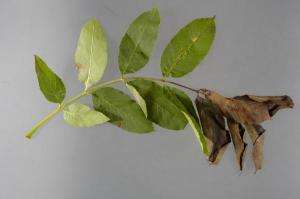Researchers uncover the origins of ash tree dieback and set out ways to fight it

Researchers from 35 European countries shared and analysed data on ash dieback across the entire continent over a four-year period, identifying the causes, effects and ways to counter the phenomenon. An invasive species originating from East Asia, the fungus was first seen in Eastern Europe in 1992. It is now threatening one of Europe's most common tree species, killing millions of ash trees across the entire continent.
The disease attacks virtually every part of the tree, from its root collar, stem, to its branches, leaves and seeds.
The impact is twofold, both economical and environmental. Ash dieback threatens hundreds of species of lichens, mosses, fungi, birds and plants that depend on the survival of the ash trees. Research suggests the tree species that would eventually replace ash would not be able to preserve the features of the initial ecosystems.
FRAXBACK managed to coordinate scattered national initiatives meant to counter the disease. Thanks to their collaboration within the network, researchers published guidelines on sustainable ash tree management for landowners, forest managers, policy makers and researchers working in the field.
Network members found ash trees that looked healthy in already devastated areas. This could imply some equally exposed ash could be resistant or tolerant to ash dieback. In response to this, FRAXBACK researchers started listing, GPS mapping and regularly monitoring those specimens across different countries. This way, they could collect genetic material in order to hopefully breed disease-resistant trees. Researchers also recommend focusing on ash clones in seed orchards that have shown a high tolerance to the disease over several years.
A team of researchers from the UK, Ireland and Denmark started sequencing the ash tree genome and started sharing their data with FRAXBACK in 2013. Their research received national funding in response to the threat of the fungal disease, first identified in natural woodland across the United Kingdom in 2012. By then, it had already wiped out 90% of the entire ash tree population in Denmark.
The team surveyed the entire ash tree DNA variation across Europe and predicted that some British ash trees were more resistant to the fungus than the Danish ones. This was an important step forward in breeding disease tolerant ash trees. Some of the team members are now receiving state funding for the Living Ash Project in order to locate and secure ash trees based on their observed susceptibility to ash dieback and include them in a future breeding programme.
One of the highlights of Action FRAXBACK was the conference on guidelines and strategies for countering ash dieback held in late 2014 at the Linnean Society of London. Dr Richard Buggs at Queen Mary University of London, who led the research team sequencing the ash tree DNA, opened the livecast conference, hosting policy makers, researchers and other governmental organisations from various European countries.
However, despite the progress, both FRAXBACK leader Dr Rimvydas Vasaitis at the Swedish University of Agricultural Sciences and Dr Richard Buggs - also participating in the network - stressed their concern about the seriousness of the epidemic. They explain that even with modern genetic techniques, it will take many years to breed ash trees with no susceptibility to the fungus. The battle has only just started.
Research has also shown Danish ash trees that show more resistance to the fungus, seem to produce fewer chemicals protecting them against insects, such as the alien species emerald ash borer - a beetle that can kill ash forests a lot faster than the ash dieback disease.
The challenge now is to identify pathways to breed trees with genes for resistance to both the insect and the ash dieback.
Provided by COST



















